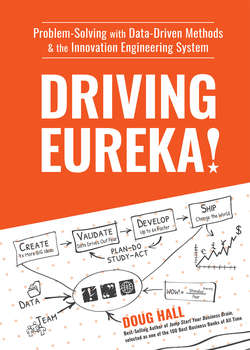Читать книгу Driving Eureka! - Doug Hall - Страница 51
На сайте Литреса книга снята с продажи.
A New Way of Learning—Cycles to Mastery
ОглавлениеJake Ward of the University of Maine first identified that we needed to develop both a great curriculum and a new way of learning. Creating a new way of teaching was especially important because, as a new field of study, there was not a base of faculty who had the breadth and depth of experience with system-driven innovation.
Two years of R&D later, a new system of teaching was born and branded as Cycles to Mastery. Its purpose is to enable all who are willing to achieve mastery of Innovation Engineering. It’s based on iterative cycles of learning. It blends: 1) the work of Benjamin Bloom on the 2 Sigma Problem, 2) formative assessment, 3) Deming PDSA cycles, 4) quality control charting, 5) flipped classroom, and 6) competency-based learning. It involves five different types of classes:
DIGITAL CLASS: These classes involve five- to seven-minute videos that cover the core content of each of the Innovation Engineering subskills. Interactive quizzes feed forward what students have learned and not learned to the instructor, so that adaptations can be made in the next class.
LAB CLASS: The digital content is made real through group and individual assignments in which students get hands-on understanding of the content. Feedback loops provide grading of each assignment. Each student is given the opportunity to resubmit till they achieve success. The percentage correct on each assignment is fed forward to the instructor, so that the next class can be modified appropriately.
APPLICATION CLASS: Students are challenged to put the subskill learning into a broader context. Students apply the new learning plus prior learning on realistic scenarios or challenges.
REFLECTION CLASS: Students write a reflection on what they have learned and how they can apply it in their lives. This solidifies the learning at a deeper level.
EXPERIENCE CLASS: These are real-world challenges. They are used to bring the learning to life. Off campus, the experience class involves coaching the student in applying the learning to their daily work. On campus, the experience is flexible. It can be part of an internship. It can be creating a new invention, starting a company, or leading an innovation project for the university that the student attends.
Cycles to Mastery has been shown to generate 200% to 400% increases in the number of students achieving mastery levels versus the classic teaching approach. Multiple learning experiences take the student from intellectually knowing to deeply understanding the skills.
When we teach Innovation Engineering on college campuses, the students get rich repetition. Off campus, we accomplish repetitions by coaching the students as they apply the learning to their projects. Ken Grier, creative director for the Macallan and an Innovation Engineering Black Belt, feels that applying his learning to his work was the most valuable part of the process: “The forced rigor of actually doing it, practicing it, getting coaching feedback was 70% of my learning.” Ken’s observation of the importance of hands-on application was confirmed by Deming Master Walter Werner: “Education begins when you leave school, not while you are there. The classroom is not the hard part, not even close.”
The most exciting aspect of Cycles to Mastery is that it includes a system for never-ending increases in the mastery standard. Control charts identify when the classes are so effective that student learning has risen above control limits. This signifies that it’s time to increase the difficulty of assignments and therefore raise the mastery standards. In effect, Cycles to Mastery delivers “Learning Inflation” instead of “grade inflation.”
On campus, students give enthusiastic support for the Cycles to Mastery teaching method.
How is this better? Less stress. This approach allows the information to stick in your head so you don’t forget it. The applying is the important part that makes it stick. No more information regurgitation.
Failing isn’t a bad thing here. You lose your fear of failing here, because it’s okay. Because you are doing live grading, it’s like [the instructors] are working with us, not against us.
I’ve always struggled with regular lectures and I am always wondering if I’m really learning, but with this I feel like I am actually learning and actually building skills.
Compared to old classes, here you are learning a new way to think, not just the content. Working on changing the mind instead of cramming it with information.
This is the best thing that ever happened to any college.
In retrospect, the decision to invest the time, energy, and money to invent a new system of teaching is probably the most important decision we have made. It has enabled us to have a scalable system for truly democratizing innovation across entire companies, countries, and cultures.
Quite simply, if you are willing, you will be made able to master the Innovation Engineering body of knowledge. We have successfully taught artists, scientists, engineers, economists, politicians, lawyers, accountants, musicians, and poets. We are so confident in the teaching system that we offer an ironclad guarantee—IF YOU ARE WILLING, YOU WILL BE MADE ABLE. You are guaranteed achieving mastery if you put in the time and follow the Cycles to Mastery methodology.
